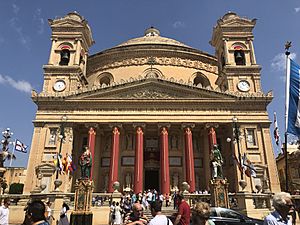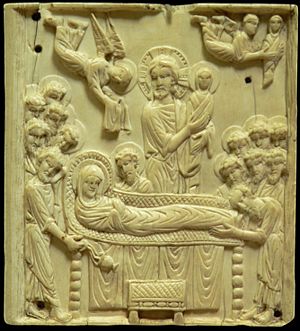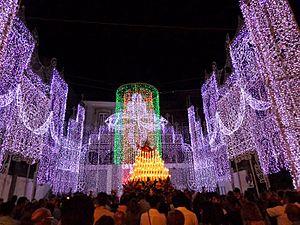Assumption of Mary facts for kids
Quick facts for kids Assumption of the Blessed Virgin Mary |
|
|---|---|
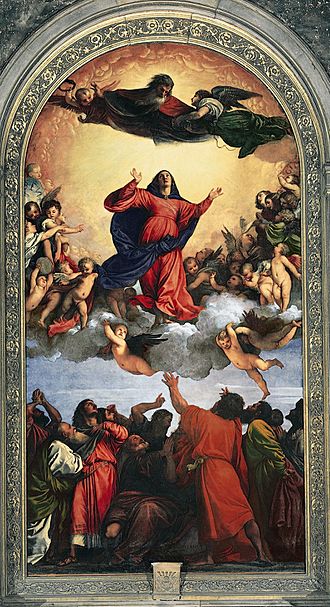
A famous treatment in Western art, Titian's Assumption, 1516–1518
|
|
| Also called |
|
| Observed by |
|
| Type | Christian |
| Significance | the bodily taking up of Mary, the mother of Jesus into Heaven |
| Observances | Attending Mass or service |
| Date | August 15 Sunday nearest to August 15 (Armenian Apostolic Church) |
| Frequency | Annual |
The Assumption of Mary is a special belief in the Catholic Church. It teaches that Mary, the mother of Jesus, was taken up into Heaven with her body and soul after her life on Earth ended. This belief is called a "dogma," which means it's a core teaching that Catholics must believe.
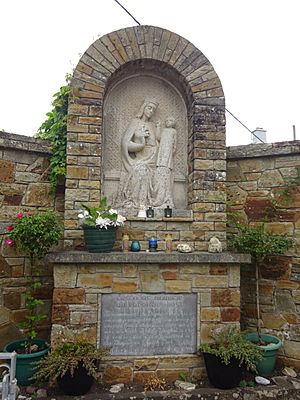
Pope Pius XII officially defined this belief in 1950. He stated that Mary, who was always pure, was taken "body and soul into the glory of heaven." This idea builds on another belief from 1854, called the Immaculate Conception of Mary. This earlier belief says that Mary was born without original sin, a concept in Christianity about human nature. Both beliefs are connected to Mary being seen as the Mother of God.
The Catholic teaching doesn't say if Mary died before she was taken to Heaven or if she went without dying. This question is left open. In the Eastern Orthodox Church, there's a similar belief called the Dormition of the Mother of God, or "Falling Asleep of the Mother of God." However, it's not a strict dogma in the same way. The word "assumption" comes from the Latin word assūmptiō, which means "taking up."
Contents
What are the Traditions About the Assumption?
The Catholic Church has two main stories about Mary's Assumption or Dormition.
- One tradition says she died, then was brought back to life for a short time, and then went to Heaven.
- The other tradition says she was taken directly into Heaven with her body before she died.
Some stories say the Assumption happened in Ephesus, at the House of the Virgin Mary. However, older traditions suggest Mary's life ended in Jerusalem, near what is known as "Mary's Tomb."
By the 600s AD, a new part of the story appeared. It says that one of Jesus's apostles, often Thomas the Apostle, arrived late to Mary's burial. When her tomb was opened for him, it was empty except for her burial clothes. Later stories even say Mary dropped her belt down to Thomas from Heaven as proof. Many old paintings show this moment.
The belief in Mary's Assumption spread widely in the Christian world. It was celebrated as early as the 400s AD. Emperor Maurice helped establish it in the East around 600 AD.
How Did the Belief in the Assumption Develop?
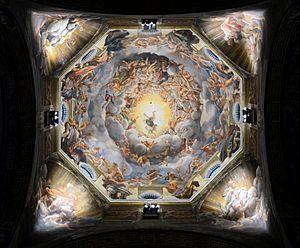
Some experts believe that stories about Mary's Dormition and Assumption can be found in very old, unofficial Christian writings. These writings might date back to the 200s or 300s AD. Some scholars think that early Christians in Jerusalem kept alive oral stories about the end of Mary's life. This suggests the stories might have some historical roots. However, other experts point out that these early stories are quite different from each other. This means they might have come from many different sources, not just one unified tradition.
One of the earliest known stories about Mary's life ending and her Assumption is called Liber Requiei Mariae ("Book of Mary's Repose"). This book is from the 200s or 300s AD. Other early writings, like "The Dormition/Assumption of Mary" and the "Six Books Dormition Apocryphon," also mention the Assumption.
It's important to know that the New Testament (the second part of the Christian Bible) doesn't say anything about how Mary's life ended. Early Christians also didn't write much about her death. In the late 300s, a writer named Epiphanius of Salamis said he couldn't find any official church tradition about it. However, his writings also show that people already had different ideas about what happened to Mary. Some thought she died a normal death, some thought she was a martyr (died for her faith), and some thought she didn't die at all. In another text, Epiphanius even compared Mary to Elijah, a prophet who was taken to Heaven without dying.
Later unofficial writings, like De Obitu S. Dominae and De Transitu Virginis (both from the 400s AD), also talk about the Assumption. By the early 700s, the belief was so strong that John of Damascus wrote about the common Eastern tradition: "Mary died in the presence of the Apostles, but that her tomb, when opened, upon the request of St Thomas, was found empty; wherefrom the Apostles concluded that the body was taken up to heaven."
The Feast of the Dormition came to the Western Church from the East in the early 600s. By the 800s, its name changed to Assumption in some church calendars. Popes like Leo IV and Nicholas I made the feast very important, putting it on the same level as Christmas and Easter. This showed how important Mary's journey to Heaven was considered.
Understanding the Assumption: Beliefs and Bible Connections
What Do Theologians Say?
When Pope Pius XII officially declared the Assumption a dogma, he used the phrase "having completed the course of her earthly life." This phrase leaves open the question of whether Mary died before she was taken to Heaven. Many Catholics believe she didn't die but was taken directly to Heaven. Both ideas are accepted within the Catholic Church.
Many church leaders and scholars believe that Mary did die. They think it was fitting for her body, which was naturally mortal, to experience death, just like her son, Jesus. However, because she was free from sin, her death was not a punishment for sin. The Assumption is seen as a special gift to Mary because she was the Mother of God.
Does the Bible Mention the Assumption?
Pope Pius XII said that the belief in the Assumption is based on the Bible. However, he didn't point to one specific Bible verse as direct proof. One important advisor, Father Jugie, thought that Revelation 12:1–2 was the main Bible passage supporting the Assumption:
And a great sign appeared in heaven: a woman clothed with the sun, and the moon under her feet, and on her head a crown of twelve stars; and she was with child ...
—Revelation 12:1–2
This verse uses symbols from the Old Testament. The woman is often seen as representing God's faithful people, like Israel and the Church. In Catholic thought, Mary is also seen as the Mother of the Church. So, there's a connection between this heavenly woman and Mary's Assumption.
Many bishops also pointed to Genesis 3:15, where God speaks to the serpent in the Garden of Eden:
Enmity will I set between you and the woman, between your seed and hers; he will strike your head, and you will strike his heel.
—Genesis 3:15
The Catholic Church teaches that this verse uses symbolic language. The serpent represents Satan. The "woman" here is connected to Mary, and the verse is seen as an early hint of Mary's special role and victory over evil.
Other Bible passages noted by the Pope include:
- Psalm 132:8, which talks about the Ark of the Covenant returning to Jerusalem. The Ark is seen as a symbol of Mary.
- Revelation 11:19, where John sees the Ark of the Covenant in Heaven, right before the vision of the woman.
- Luke 1:28, where the Archangel Gabriel greets Mary with "Hail Mary, full of grace." Mary's Assumption is seen as a natural outcome of being "full of grace."
- 1 Corinthians 15:23 and Matthew 27:52–53, which speak about the certainty of bodies rising again for those who believe in Christ.
Assumption vs. Dormition: What's the Difference?
Some Catholics believe Mary died before being assumed, but that she was brought back to life before going to Heaven. Others believe she went to Heaven directly without dying. Both beliefs are accepted by Catholics. Eastern Catholics celebrate this day as the Dormition.
In the Catholic Church, the Assumption is a "dogma," meaning it's a very clear and official teaching. In the Eastern Orthodox tradition, the Dormition is more of a liturgical (worship-related) and mystical (spiritual) belief, rather than a strict dogma. This difference comes from how the two traditions define their beliefs. The Catholic Church often has more central and official definitions, while Eastern Orthodoxy allows for more varied interpretations.
The Latin Catholic Feast of the Assumption is on August 15. The Eastern Orthodox and Eastern Catholics celebrate the Dormition of the Mother of God on the same date. This is usually after a 14-day fast. Eastern Christians believe Mary died a natural death, her soul went to Christ, her body was brought back to life, and then she was taken to Heaven. This is seen as a preview of the general resurrection for everyone.
How Do Protestants View the Assumption?
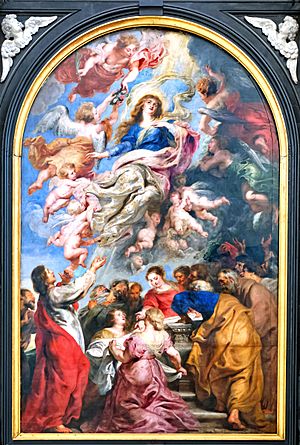
Views among Protestants vary. Some Protestant groups, whose beliefs are closer to Catholicism, might believe in a bodily assumption. However, most Protestants do not.
Lutheran Views
The Feast of the Assumption of Mary was kept by the Lutheran Church after the Reformation. Today, some Lutheran calendars call August 15 "Mary, Mother of Our Lord" or "St. Mary, Mother of our Lord."
Anglican Views
Within Anglican doctrine, the Assumption of Mary is either not accepted or seen as "adiaphora" (something not essential). It was removed from Anglican worship in 1549. However, some parts of Anglicanism brought it back in the 1900s under different names. The Church of England celebrates August 15 as a feast day for the Blessed Virgin Mary. The Scottish Episcopal Church calls it "Mary the Virgin." In the US-based Episcopal Church, it's "Saint Mary the Virgin: Mother of Our Lord Jesus Christ." Other Anglican churches, like the Anglican Church of Canada, celebrate it as the "Falling Asleep of the Blessed Virgin Mary" (Dormition).
A group working to find common ground between Anglicans and Roman Catholics stated in 2004 that the teachings about Mary's Assumption and Immaculate Conception can fit with what the Bible teaches and with ancient Christian traditions.
Other Protestant Views
The Protestant reformer Heinrich Bullinger believed in the Assumption of Mary. In 1539, he wrote that Mary's "most holy body, was carried to heaven by angels."
Feasts and Fasting Periods
Orthodox Christians often fast for fifteen days before the Feast of the Assumption of Mary. Fasting in the Orthodox tradition means not eating a meal until evening.
The Assumption is very important to many Christians, especially Catholics and Orthodox, as well as many Lutherans and Anglicans. It's seen as Mary's heavenly birthday, the day she was welcomed into Heaven. For some Christians, Mary's acceptance into Heaven is a symbol of Jesus's promise that all faithful Christians will also be received into paradise. The Assumption of Mary is sometimes symbolized by the Fleur-de-lys Madonna.
The Italian name for the holiday, "Ferragosto", might come from the Latin Feriae Augusti ("Holidays of the Emperor Augustus"). The month of August was named after this emperor. The feast was started by Bishop Cyril of Alexandria in the 400s AD and placed on August 15. This date was already a public holiday in the Roman Empire, celebrating Emperor Augustus's victories.
The Solemnity of the Assumption on August 15 has been celebrated in the Eastern Church since the 500s. The Western Church adopted this date as a Holy Day of Obligation. This means Catholics are expected to attend Mass on this day to remember the belief that Mary's sinless soul and body were truly taken up into Heaven.
Public Holidays

Assumption Day on August 15 is a public holiday in many countries around the world. These include Andorra, Austria, Belgium, Burundi, Cameroon, Central African Republic, Chile, Republic of Congo, Côte d'Ivoire, Croatia, Colombia, Costa Rica, Cyprus, East Timor, France, Gabon, Greece, Georgia, Republic of Guinea, Haiti, Italy, Lebanon, Lithuania, Luxembourg, Republic of North Macedonia, Madagascar, Malta, Mauritius, Republic of Moldova, Monaco, Montenegro (for Albanian Catholics), Paraguay, Poland (which also celebrates Polish Army Day), Portugal, Romania, Rwanda, Senegal, Seychelles, Slovenia, Spain, Syria, Tahiti, Togo, and Vanuatu. It was also a holiday in Hungary until 1948.
It's also a public holiday in parts of Germany (like Bavaria and Saarland) and Switzerland (in 14 of its 26 cantons). In Guatemala, it's celebrated in Guatemala City and Santa Maria Nebaj, where Mary is the patron saint. In Costa Rica and parts of Belgium, this day is combined with Mother's Day.
Some countries where Assumption Day is an important festival but not a public holiday include the Czech Republic, Ireland, Mexico, the Philippines, and Russia. In Bulgaria, it's the biggest Eastern Orthodox Christian celebration of the Holy Virgin. Celebrations include church services and offerings. In Varna, Bulgaria, there's a procession with a holy icon, concerts, and boat races.
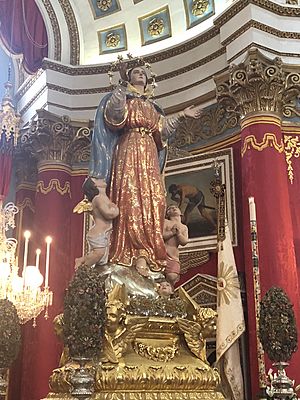
In many places, religious parades and festivals are held to celebrate this day. In Canada, Assumption Day is the national holiday for the Acadian people, as Mary is their patron saint. Some businesses in French-speaking parts of New Brunswick, Canada, close on this day. The Virgin Assumed in Heaven is also the patroness of the Maltese Islands. Her feast on August 15 is a public holiday in Malta and is celebrated with great importance in local churches, especially in seven towns known as the Seba' Santa Marijiet. These Maltese towns are: Il-Mosta, Il-Qrendi, Ħal Kirkop, Ħal Għaxaq, Il-Gudja, Ħ'Attard, L-Imqabba, and Victoria. In Praha, Texas, a small town holds a festival where its population grows from about 25 to 5,000 people.
In Anglicanism and Lutheranism, the feast is often observed, but without officially using the word "Assumption." In Eastern Orthodox churches that follow the Julian Calendar, the Feast of the Assumption of Mary falls on August 28.
Art
The earliest known artwork showing the Dormition is on a stone coffin in a church in Zaragoza, Spain, from around 330 AD. The Assumption became a popular topic in Western Christian art, especially from the 1100s onwards. It became even more popular after the Reformation, when it was used to highlight Mary's importance. In these artworks, angels often carry Mary to Heaven, where she is crowned by Christ. Below, the Apostles gather around her empty tomb, looking up in wonder.
See also
 In Spanish: Asunción de María para niños
In Spanish: Asunción de María para niños


